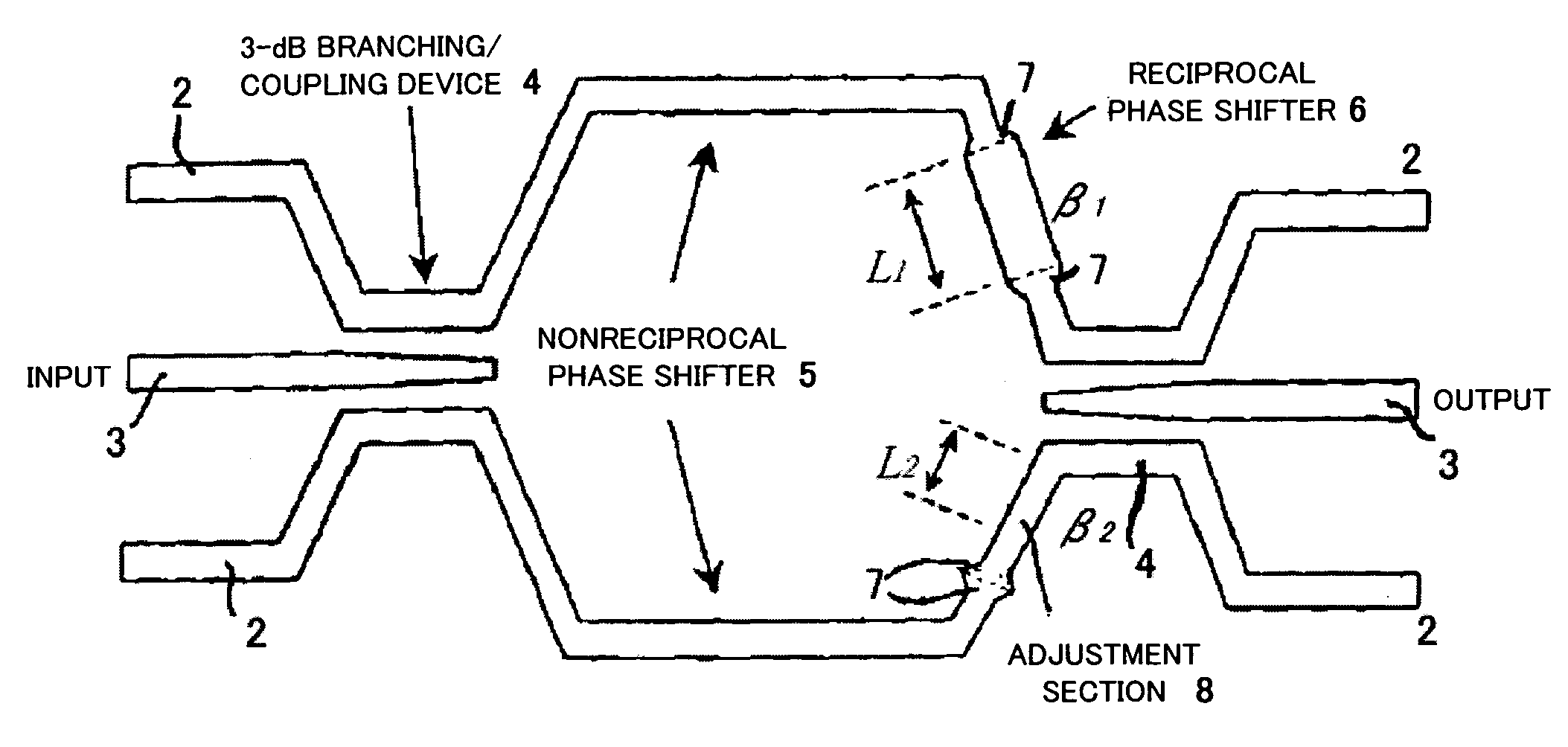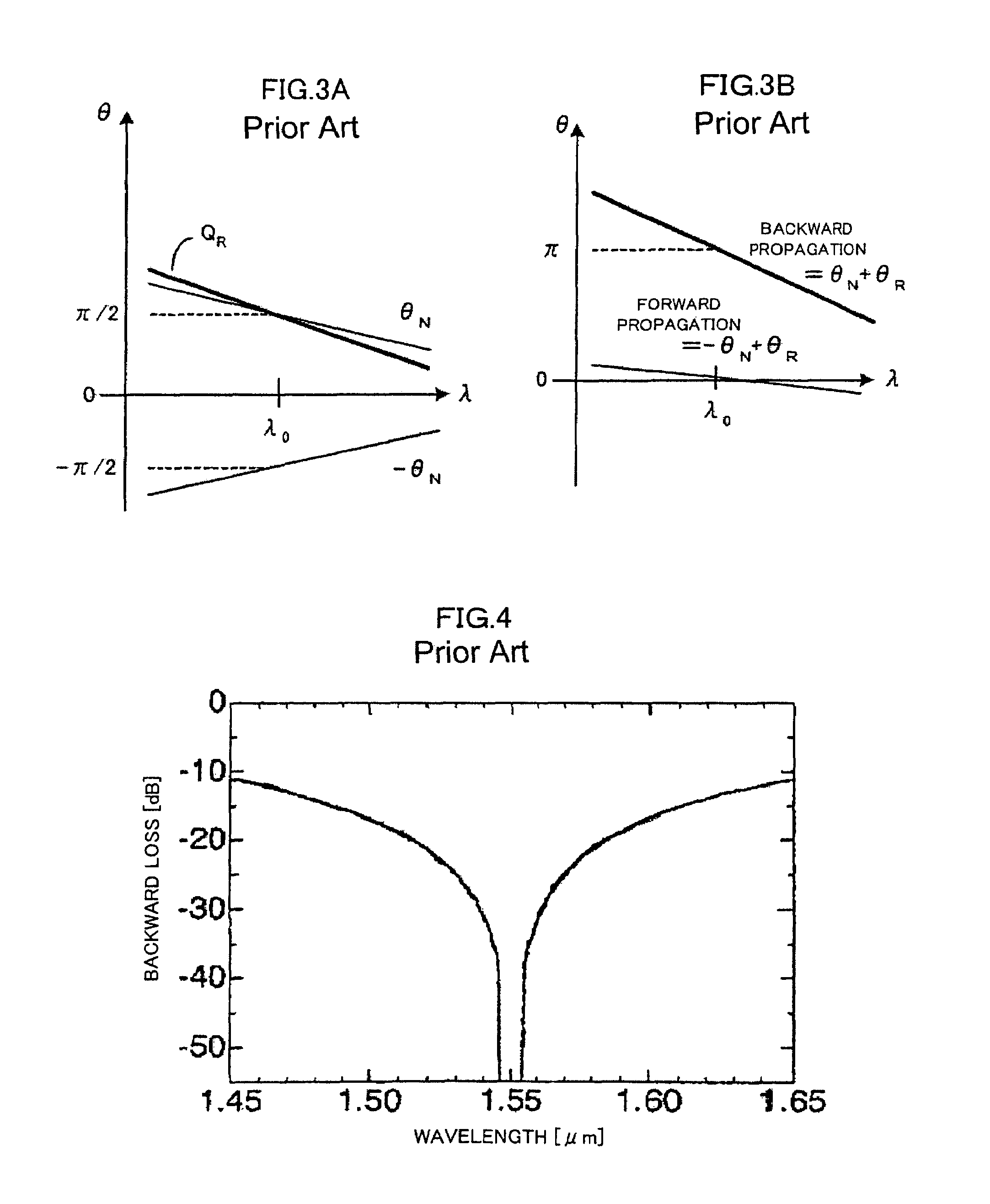Waveguide-type broadband optical isolator
a broadband optical isolator and waveguide technology, applied in the direction of optical waveguide light guide, optical light guide, instruments, etc., can solve the problems of unintentional behavior, degrade the oscillation characteristics of semiconductor lasers, and degrade the operation characteristics of devices
- Summary
- Abstract
- Description
- Claims
- Application Information
AI Technical Summary
Benefits of technology
Problems solved by technology
Method used
Image
Examples
embodiment-1
[0089]Band broadening in a waveguide-type optical isolator having a waveguide layer comprising the magneto-optical material Ce:YIG (CeY2Fe5O12) shown in FIG. 19 will now be described as Embodiment-1.
[0090]Since “Ce:YIG” is the magneto-optical material, the wavelength-dependence of the Faraday rotation coefficient of “Ce:YIG” must be considered. For the wavelength-dependence of the Faraday rotation coefficient of “Ce:YIG”, “Ce:YIG” having the values shown in FIG. 11 is used. Further, for the wavelength-dependence of the refractive index of “Ce:YIG”, “Ce:YIG” having the values shown in FIG. 12 is used. On the basis of these values, a waveguide-type optical isolator having a waveguide layer comprising “Ce:YIG” is considered.
[0091]The layer structure of the waveguide is air (upper clad) / Ce:YIG (waveguide layer) / NOG (lower clad). In order to minimize the wavelength-dependence of the backward propagating waves, the reciprocal phase shifter 6 shown in FIG. 9 is formed in which L1=10.0 [μm]...
embodiment-2
[0094]Band broadening in a waveguide-type optical isolator having a waveguide layer comprising “Si”, as shown in FIG. 22, will now be described as Embodiment-2.
[0095]The layer structure of the present waveguide-type optical isolator is Ce:YIG (upper clad) / Si (waveguide layer) / SiO2 (lower clad layer). For the wavelength-dependence of the Faraday rotation coefficient of the upper clad Ce:YIG, “Ce:YIG” having the above-described value using FIG. 11 is used, for the wavelength-dependence of the refractive index of the waveguide layer Si, “Si” having a value shown in FIG. 23 is used, and for the wavelength-dependence of the refractive index of the substrate SiO2, “SiO2” having a value shown in FIG. 16 is used. The present waveguide-type optical isolator is an example of an ultra-small optical isolator formed from an SOI-wafer (Si / SiO2 / Si), and is used as an optical isolator for use in silicon-photonics optical circuits. In FIG. 22, although a multimode interference coupling device (an MM...
embodiment-3
[0099]A characteristic of a waveguide-type broadband optical isolator having a central wavelength of 1.55 [μm] is shown. The waveguide structure of which is shown in FIG. 14, in which L1=900 [μm], L2=899.55 [μm], W1=2.4 [μm], W2=2.0 [μm] and Lt=10 [μm]. The wavelength-dependence of the loss of a light wave entering the waveguide-type optical isolator obtained by the above design is shown in FIG. 26. The loss amount for the backward propagating waves is indicated by a solid line, while the loss amount for the forward propagating waves is indicated by a broken line. Over the wavelengths in the range of 1.4 [μm] to 1.65 [μm], the backward loss remarkably exceeds 30 [dB], which is a value conventionally required. As the deviation of the wavelength of incident light from 1.55 [μm] increases, the forward loss increases, but the wavelength-dependence of an isolation ratio defined by “backward loss−forward loss” is approximately determined by the wavelength-dependence of the backward loss, ...
PUM
 Login to View More
Login to View More Abstract
Description
Claims
Application Information
 Login to View More
Login to View More - R&D
- Intellectual Property
- Life Sciences
- Materials
- Tech Scout
- Unparalleled Data Quality
- Higher Quality Content
- 60% Fewer Hallucinations
Browse by: Latest US Patents, China's latest patents, Technical Efficacy Thesaurus, Application Domain, Technology Topic, Popular Technical Reports.
© 2025 PatSnap. All rights reserved.Legal|Privacy policy|Modern Slavery Act Transparency Statement|Sitemap|About US| Contact US: help@patsnap.com



